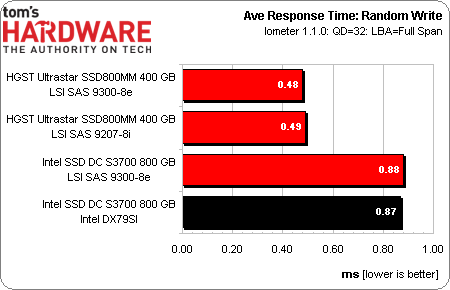LSI SAS 9300-8e & HGST Ultrastar SSD800MM: 12 Gb/s SAS, Tested
With the announcement of LSI's SAS 9300-8e and HGST's Ultrastar SSD800MM earlier this year, the world was officially introduced to 12 Gb/s SAS. Today we get our first look at how two times the interface bandwidth translates to real-world performance.
Results: 4 KB Random Performance And Latency
With a specification claiming 145,000 random read IOPS, we hoped we were in for a treat. Needless to say, the SSD800MM delivered. Achieving almost 150,000 IOPS, it almost doubled the SSD DC S3700's performance. When we moved it to a 6 Gb/s connection, the SSD800MM still delivered 110,000 random read IIOPS, clearly smoking the SSD DC S3700. In fact, that number is also higher than other SAS-based enterprise SSDs, such as the Smart Optimus, which top out at nearly 100,000 IOPS.
Finally, we tested Intel's SSD DC S3700 on both the LSI SAS 9300-8e and our system's built-in SATA ports. As you can see, the 6 Gb/s drive fares almost the same, regardless of where it's plugged in.
As we saw in our random read test, the SSD800MM out-muscles Intel's SSD DC S3700 at every queue depth. Although we didn't quite hit the 70,000 IOPS specified by HGST, 66,000 IOPS still comes very close to doubling the SSD DC S3700's performance. Stepping up to 12 Gb/s doesn't get us much in this random write test. Even though 66,000 IOPS is a large number, it wouldn't overwhelm a 6 Gb/s interface.
We did observe more consistent performance from the SAS 9300-8e at lower queue depths, but once you hit a queue depth of 64, the advantage disappears. Also, LSI's SAS 9300-8e falls a little behind Intel's on-board SATA controller, as the green line edges above the blue. Fortunately, the difference is less than 2% at most queue depths.
A look at average response times shows us that these results correspond well with the line charts. The SSD800MM performs slightly better on the SAS 9300-8e, while X79 Express chipset edges out the add-in 12 Gb/s HBA. In both cases, those advantages are a scant 10 μs.
In our maximum response time test, the SSD DC S3700 attains a rare victory. The differences are so minor, though, that they're hardly significant. To truly determine performance consistency, we need to look at latency over time.
Get Tom's Hardware's best news and in-depth reviews, straight to your inbox.
Current page: Results: 4 KB Random Performance And Latency
Prev Page Test Setup, Benchmarks, And Methodology Next Page Results: Performance Consistency-
major-error The performance and relative maturity of this prototype drive certainly is impressive, but this is what the enterprise space demands.Reply
At the consumer level though, the article takes on a completely different tone--I would be very surprised if we don't start seeing mention of PCIe4 at/before the top of the next CPU cycle (so, in 24-36 months at most.) -
raidtarded Actually, Adaptec already saturated PCIe 3.0 with 6GB/s. The chart is incorrect, it doesn't take 12Gb/s to saturate the PCIe bus. Well, not for Adaptec.Reply -
falcompsx Remember when mechanical hard drives struggled to saturate their interfaces? Times sure have changed with SSD tech.Reply -
CaedenV Reply11006286 said:The performance and relative maturity of this prototype drive certainly is impressive, but this is what the enterprise space demands.
At the consumer level though, the article takes on a completely different tone--I would be very surprised if we don't start seeing mention of PCIe4 at/before the top of the next CPU cycle (so, in 24-36 months at most.)
Ya, my bet is that we will not start to see SATA4 or PCIe4 until Skymont at the earliest. Considering it is looking like Broadwell may be pushed back due to 14nm die shrink issues I would bet that Skymont will have similar issues when moving to 10nm. But at least for home users you can cram 2 SSDs in RAID0 with a proper RAID card and get a little performance boost until then. I guess the only problem is that most people are going to use the onboard Intel RAID for RAID0, which will get you a killer synthetic benchmark, but in practical reality it is really just expanding your volume with very little speed benefit. -
bit_user * wipes drool off floor *Reply
That's a quality review of some quality products. I like the insights shared, throughout. I especially appreciated the link to the SATA-Express paper. Thanks!
MORE REVIEWS LIKE THIS!!
:) -
bit_user Reply
How many ports and how many lanes, though? If it's just a 8-port card, the math doesn't support that, as 6x8 = 48 Gbps, which is less than the 8 x 8 = 64 Gbps that a x8 PCIe 3.0 slot should carry.11006482 said:Actually, Adaptec already saturated PCIe 3.0 with 6GB/s. The chart is incorrect, it doesn't take 12Gb/s to saturate the PCIe bus. Well, not for Adaptec.
-
raidtarded It is the equivalent of a nuke bomb compared to the LSI products. It has 24 Native ports.Reply11011736 said:
How many ports and how many lanes, though? If it's just a 8-port card, the math doesn't support that, as 6x8 = 48 Gbps, which is less than the 8 x 8 = 64 Gbps that a x8 PCIe 3.0 slot should carry.11006482 said:Actually, Adaptec already saturated PCIe 3.0 with 6GB/s. The chart is incorrect, it doesn't take 12Gb/s to saturate the PCIe bus. Well, not for Adaptec.



